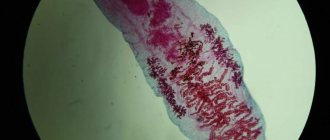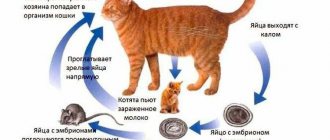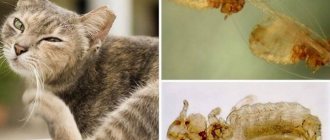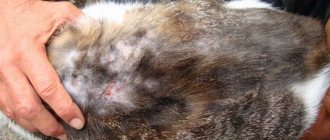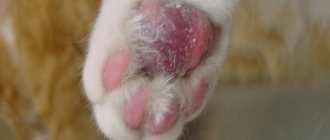According to unofficial statistics, every third family in Russia has pets, more than half of them are cats. These cute creatures, just like people, can suffer from various diseases, including worms. Symptoms of worms in cats at first after infection may not have a pronounced clinical picture, but after a certain period of time has passed, the animal usually loses weight, feels unwell and has stomach upsets. Today we will talk about the symptoms of lungworms in cats.
Helminthiasis in cats
One of the most common diseases in cats is helminthiasis - infection of an animal with worms. Today, veterinarians identify several types of helminths. When worms are detected in cats, it is first of all important to correctly identify the type of parasite that has settled in the animal’s body, which will allow the correct course of treatment to be prescribed. One of the most common diseases in cats is considered to be helminthiasis - infection of an animal with worms.
Parasites that have entered the animal’s body, which can be found almost everywhere: in grass, raw foods, water, etc., pose a potential danger not only to the health of the cat, but also to its owner. Even if an adult cat or kitten is constantly in the house, this does not exclude their infection with helminth eggs, which can be carried by dirty shoes, clothes or even unwashed hands. Helminths, also known as worms, along with bacteria and viruses, have a huge negative impact on the cat’s health . When eggs or larvae of parasitic worms enter the animal’s body, the latter is not able to develop specific immunity against such a foreign invasion and independently fight the disease.
Whereas when microbes enter, the immune system reacts by releasing antibodies that can block the infection. Due to this state of affairs, there is still no vaccine against helminthiasis, although experiments in this direction are being conducted. Sometimes they are not unsuccessful.
What to pay attention to
A cat's cough, the causes and treatment of which can be different, worries all owners who are faced with unfamiliar and frightening symptoms. Of course, it is better to immediately contact a veterinarian. But if this is not possible, you can try to understand what the problem is. Sometimes a cat's cough is completely harmless and goes away on its own. In other cases, specialist help will be required.
You can understand why a cat coughs and how to treat it in each specific case by assessing the general condition of the animal and specifying the presence or absence of other characteristic signs. It is also necessary to record the number and duration of attacks, and understand what time of day they occur.
Sneezing and coughing indicate that something is irritating the cat's mucous membranes. The reaction to viruses, parasites or a foreign body can be almost the same. The animal rubs its muzzle with its paw, tilts its head, stretches its neck, trying to get rid of unpleasant sensations. Sneezing is most often associated with a problem in the nose area, while coughing indicates that the irritant has reached the mucous membrane of the throat.
Where do worms live in a cat's body?
Signs of the disease when parasitized by one or another type of worm in cats are largely determined by the location of the infestation. And there are quite a lot of these places in the body. Worms can settle and subsequently destroy the balance of a living system in almost any organ. They can be found in: intestines; stomach; liver; lungs; kidneys; bladder; and even in the heart or eyes. Mainly felines are affected by: intestinal parasites - roundworms (ascariasis, toxacariasis); liver - flukes (opisthorchiasis).
In rare cases, helminths can be found in organs and tissues of the host that are unusual for their biology, then they speak of “perverted localization.” With this form of the disease, the parasitic worm for the most part cannot complete the full course of development, but the body still experiences some signs of discomfort.
In addition, there is a so-called transit localization, when larvae or eggs pass through the cat’s body without stopping anywhere and without having any negative impact on health.
Complications caused by worms
The level of harm caused by worms depends on the degree of lung damage, the stage of progression of the inflammatory process and the number of infective larvae. Minor pulmonary lesions may go unnoticed. In severe stages of infection, an increase in body temperature is often observed.
The presence of worms in the lungs causes damage to the respiratory system. The inflammatory reaction is fraught with the development of serious pathologies. Among the main complications are interstitial emphysema. In this case, there is an accumulation of small bubbles containing air in the area of the lung tissue. This causes the development of edema and secondary bacterial pneumonia.
The chronic form of helminthiasis in domestic animals and cattle leads to scarring of the lung tissue. This is fraught with lifelong chronic cough, which does not go away even after antiparasitic treatment.
We have already noted that the latent stage of the disease can last up to six months, and in some animals there are no pronounced clinical signs (except for a moderate cough) at all. But this does not mean at all that the disease (even if the worms die of old age) passes without leaving a trace on the pet’s health:
- There is a high risk of developing pulmonary emphysema. This disease is usually irreversible; the affected animal will experience difficulty breathing for the rest of its life.
- It is much worse when the “work” of the worms led to the formation of adhesions and adhesions in the lung tissue or pleura. In this case, the pet will almost certainly receive a whole “bouquet” of chronic diseases of the respiratory system. In addition, the presence of nodules and adhesions is a sure guarantee that the cat will experience pain simply when breathing.
- In addition, in older pets who have had pulmonary helminthiasis, the risk of cancer of the respiratory system increases significantly. This is due both to the deterioration of the immune resistance of the elderly individual’s body, and to the damage that parasites will inevitably cause to the lung tissue.
Even if a cat survives without professional veterinary care, it will most likely suffer from a painful, dry cough for the rest of its days. In addition, in the case of damp and humid weather, the pet can instantly develop bronchitis; such animals are at great risk of suffocating from pulmonary edema at any time.
Worms in cats, main types
Many novice cat owners ask what worms look like in cats. In fact, there are many types of parasites that infect animals. Some scientists claim that there are about eighty. There are a lot of types of parasites that infect animals
But the cat has worms, the symptoms of which are most common. There are three main groups of worms: nematodes, cestodes and trematodes. They will be discussed here.
- Cestodoses. Cats become infected with these worms by eating raw meat, mice, and fish; they are carried by fleas. Diphyllobothriasis - the invasion is caused by a long, up to one and a half meter flatworm. Signs of worms in a cat associated with this parasite appear in the form of weight loss, anemia, and sometimes vomiting blood. Dipilidiosis is caused by a flatworm 20-30 centimeters long. The parasites attach to the intestinal wall, thereby destroying the mucous membrane. Animals lose weight and develop diarrhea with mucus and blood. Failure to treat worms in cats can have serious consequences. Alveococcosis is caused by a small worm that lives in the small intestine. It is not very dangerous for the animal, but these worms in cats are transmitted to humans;
- Nematodes. Toxocariasis is caused by small worms that live in the intestines and bile ducts. They are transmitted either through food or in utero. Signs of worms in a cat appear in the form of weight loss, vomiting, diarrhea, and sometimes anemia. If cats have such worms, treatment and medications must be used, because they often cause blockage of the bile ducts and intestinal obstruction. Hookworm is associated with a roundworm, about 2 mm long. It feeds on blood; if kittens have such worms, the signs will manifest themselves in the form of anemia;
- Trematodes. Paragonimiasis or lungworms. Infection occurs through eating raw fish and seafood. When these worms are present, cats may experience general symptoms - loss of appetite, fever, snoring during sleep, shortness of breath. In some cases, foamy vomiting and diarrhea are observed. The liver fluke is a worm that parasitizes the liver; infection also occurs when eating raw fish. Signs of worms in cats are expressed in severe pain (it prevents one from touching the stomach), periods of gluttony alternate with complete loss of appetite. Vomiting or diarrhea with bile may occur. In such cases, deworming tablets for cats must be given along with medications to protect the liver.
Treatment of cough with helminthic diseases
Much depends on the root cause. So, in the case of an allergic etiology of cough, the animal is prescribed antihistamines in loading doses. They will alleviate the pet’s condition by reducing the intensity and frequency of coughing attacks.
Accordingly, with a strong intensity of helminthic infestations, it is necessary to urgently use antihelminthic drugs. It should be taken into account that in a situation where there are too many parasites in the animal’s intestines, their simultaneous death will be accompanied by an avalanche-like increase in the volume of toxins.
To avoid serious consequences in the form of acute intoxication, laxatives should be added to conventional anthelmintic drugs.
Of course, they are included in antiparasitic agents by default; in such cases, their concentration may not be enough to completely evacuate the bodies of dead parasites.
The worst thing is when the entry of worms into the lungs causes the development of severe inflammation (unfortunately, this happens often). In this case, it is necessary to prescribe broad-spectrum antibiotics and other anti-inflammatory drugs. They do not have the best effect on the liver and kidneys, but there is still no other way out in such a situation.
In addition, treatment should be accompanied by intravenous administration of Ringer's solutions and glucose. This is done to quickly relieve intoxication and maintain liver and kidney function.
Types of worms in cats
- Lungworms . Infection occurs from contaminated bodies of water, through water or crustaceans. The worm forms a cyst in the lungs, gradually destroying the organ;
- wide tape. It is dangerous due to its large size up to 1.5 meters. In the human body it can reach 12 meters. Infection occurs from crustaceans, raw fish and river water;
- liver fluke. It parasitizes exclusively in the tissues of the liver, gall bladder or pancreas. Infection occurs from raw fish;
The liver fluke parasitizes exclusively in the tissues of the liver, gall bladder or pancreas
- cucumber tapeworm. Having sharp hooks, it digs into the intestinal walls and seriously damages them. Infection occurs from fleas and lice-eaters;
- toxocara. They love to settle in the intestines. They pose a mortal danger to kittens. Actively developing in a kitten’s weak body, they can lead to rupture of the small intestine. Infection occurs from food, sometimes in kittens during intrauterine development;
- causative agents of alveococcosis. They have a size of up to 5 mm, and do not pose any particular danger to the animal, but are deadly to humans (tumors of internal organs, metastases). Infection occurs due to eating rodents;
- hookworms. They grow no more than 1 cm in length. Parasitizing in the intestines, worms feed on blood. Infection occurs through food (eggs) or skin (larvae).
Treatment for worms
If the cat’s condition is satisfactory, then the owners usually carry out treatment at home. Whatever worms are found in cats, in any case, drug treatment is now mainly used.
Therefore, it is important to consult an experienced veterinarian before use.
Pills
Effective anti-parasite medications include:
- Milbemax. The cost of 2 tablets per package ranges from 350-400 rubles.
- Prazicide. The price of a package consisting of 6 tablets is 140 rubles.
- Dirofen You will have to pay 110 rubles for the packaging.
- Drontal. The cost of 1 tablet for cats against worms is 70 rubles.
- Prazitel. You need to pay an average of 65 rubles per tablet.
The tablet should be given to pets as follows: open the cat’s mouth, and then place the tablet on the root of the tongue. His swallowing reflex will work, so he will swallow the drug without assistance. If the cat categorically refuses to take the entire tablet, then it can be crushed and added to the food.
Drops
Drops are a very convenient form of the drug. Veterinarians also prescribe drops to get rid of fleas and lice. Common anthelmintic drops:
- Stronghold (price starts from 250 rubles, depending on the region of Russia it can vary by 5-10%).
- Profender (400 rubles).
- Lawyer (this is one of the most expensive means, since you will have to pay more than 1000 rubles for a bottle).
- Prazicide (270 rubles).
It is best to apply the medicine against worms on the withers, since in this place the pet will not lick the drops.
Suspensions
- Pirantel. For a 15-milliliter bottle you need to pay 50 rubles.
- Prazicide. The price of a 7 ml bottle is approximately 100 rubles.
- Prazitel. A single dosage of the suspension costs around 140 rubles.
Veterinarians recommend adding suspensions to food. Because when poured into the mouth, the cat will most likely spit the medicine back out.
Solution for injection
Pets can be treated not only with suspensions and tablets; injections also do an excellent job with this task. For example, buy the effective drug Novomek. Its price is 90 rubles for a 10 ml bottle.
If you do not have experience in giving intramuscular injections to animals, then it is better to leave this work to professionals.
Symptoms of worm infection in a cat
At the initial stage of infection, animals do not experience any unpleasant sensations. Later, with an increase in the number of parasites, this may be indicated by the following symptoms: loss of appetite, fatigue; digestive tract disorder; anemia of visible mucous membranes; deterioration in wool quality; frequent or constant itching around the anus; increased secretion of tears from the eyes. If you suspect the presence of parasites in your pet’s body, you should immediately go to the veterinarian
In the most advanced cases, cats develop blood and mucus in their stool and muscle cramps. A large number of worms can cause miscarriage in a pregnant cat. If you suspect the presence of parasites in your pet’s body, you should immediately go to the veterinarian. At the clinic, you will be asked to submit your animal's stool for laboratory testing. If worm eggs are found in it, treatment must be started immediately. Common symptoms of worms in cats:
- the presence of fleas in a cat is a direct sign of the appearance of helminths;
- Since invasive parasites can live not only in the intestines, but also in the bronchi, muscles, and liver, a number of symptoms may be observed indicating the presence of helminths. Namely: general exhaustion of the body, dull hair, lethargic condition of the pet, refusal of food or, conversely, increased appetite, thirst, weight loss, vomiting in the cat and diarrhea (the presence of parasites can be seen in the vomit or feces). Also, a small rash around the anus may indicate the presence of worms;
- kittens have swollen bellies, very pale mucous membranes (due to anemia), an upset stomach is replaced by constipation, bloody diarrhea.
Starting treatment
Such symptoms are also characteristic of other diseases that are not associated with the presence of helminths in the body. Therefore, before starting treatment, you need to consult a veterinarian. When diagnosing an infestation, the type of helminth is first determined through laboratory tests, and then drugs are prescribed that are effective in treating this type of parasite.
When there are a lot of worms, the doctor will recommend how to remove them correctly so as not to harm the animal. With sudden deworming, the animal may even die.
Signs of cat infestation with worms
- Tapeworms (cestodes) : long and flat, can reach a length of up to 70 cm. The body of these worms consists of many segments, in each of which larvae mature. When the larvae mature, they separate and come out with feces, with a segmented body The parasite grows continuously and new segments with larvae appear to replace the separated segments. Cats become infected with this type of worms by eating raw meat and fish. Stray animals often become infected with cestodes when they eat rats or mice. Infection through larval carriers, fleas, is also possible. Helminths parasitize the walls of the cat's small intestine. It is very common to see tapeworm segments around the anus of a sick animal - these segments resemble grains of rice or sesame. Also, individual parts of cestodes are found on the animal’s bedding. In a more severe form of infection with worms, parasites can be seen in the vomit. Signs of infection with tapeworms: changes in the pet’s body weight (the weight either increases sharply, or the cat, on the contrary, rapidly loses weight); change in appetite (the cat is insatiable or, on the contrary, refuses food); large, “inflated” belly; hair loss; excessive licking in the anal area;
- Roundworms : The most common type of worm in cats. There are quite a lot of them, but the most common among our pets are roundworms. In appearance, the parasites resemble spaghetti, which is where the name “round” comes from. The length of roundworms usually reaches 5 cm, but longer individuals are also found. Kittens can become infected with roundworms through their mother's milk. The danger of infection lies in wait for an adult cat when eating rodents, raw meat and in contact with an infected animal.
Roundworms: the most common type of worms in cats
Worms accumulate in the small intestine, injure the gastric mucosa, and can clog the bile ducts and intestines. They can parasitize almost all organs of the animal, having a strong toxic and allergic effect on the body. Signs of roundworm infection: weight loss; abdominal enlargement; vomit; diarrhea; weakness;
- nematodes: these are small, white, thread-like worms, measuring up to 2 cm in length. Parasites feed on the blood of their host, attaching themselves to the wall of the small intestine. They are less common in cats than other worms, but pose a mortal danger to the health of the pet. Infection with nematodes can occur when a cat comes into contact with the feces of a sick animal, as well as through contact with particles of soil contaminated with worm larvae. Symptoms of nematode infestation: weight loss; diarrhea; anemia, rashes and wounds on the skin, especially on the paws - these are traces of the migration of worms; darkening or blackness of the cat's feces, the presence of blood in the animal's stool.
How does infection occur?
Helminths can enter an animal's body in various ways. Dogs and cats can ingest them in street dust. This can happen in the yard or in the apartment. Worm eggs enter homes on a person's shoes. A cow can drink water from a pond in which helminths live. In the intestine, larvae emerge from the swallowed eggs, which quickly become sexually mature individuals and begin to multiply quickly.
From the intestines, small individuals of the larval form leak into the bloodstream, from where they are carried into the lungs. Parasites that end up in the trachea and bronchi cause mucus to accumulate inside the respiratory organs. It is this that causes difficulty in breathing and shortness of breath.
That is why, by promptly paying attention to cough, you can prevent damage to the internal organs of cats, dogs and cattle.
This is an extremely common type of parasite. Among them there are even “heart” worms that live in the aorta, pulmonary arteries and heart cavities. Fortunately, such “exotics” are extremely rare in our country. Animals usually become infected with Toxocara. The most common parasite is Toxocara cati. They are extremely invasive, widespread in the external environment, and pose a certain threat to the health of not only cats, but even humans.
The length of adult individuals can reach 10 cm, but they are usually more modest and rarely grow more than 4-5 cm. The color of tocoscaras varies from brownish to whitish-yellow, and they can occasionally be seen in feces. So, in cases where you see some “spaghetti” in your pet’s litter box, this most likely indicates an infestation of roundworms.
Experts believe that when infected with parasitic nematodes, cats may exhibit the following symptoms:
- Animals (especially kittens) become like a pear: the stomach is constantly swollen, as if the pet has just eaten a hearty meal, but at the same time signs of severe exhaustion are constantly developing. The fur of pot-bellied pets becomes stiff, the skin loses its elasticity and is noticeably dry to the touch. If you stroke a cat's chest, protruding ribs will “scream” into your hand.
- Frequent loose stools or diarrhea, interspersed with cases of “silent” constipation.
- Apathy, sickly appearance, the previously playful cat tries to spend as much time as possible huddled in a corner somewhere.
Migrating nematode larvae manifest themselves no less clearly. They, having hatched in the intestine, pierce its wall, reaching the nearest blood vessel, and then, once in the general bloodstream, they go to the lungs (pulmonary forms). There the larvae grow and develop for a couple of weeks, intensively feeding on the tissues of the long-suffering lungs.
But infections are much more prosaic - the animal simply swallows the parasite eggs along with contaminated food or water. In addition, some parasitic nematodes use intermediate hosts. If your cat has a fondness for grasshoppers or other “little things”, constantly eating them, he is also at increased risk.
You just need to remember that processing alone is usually not enough. It must be repeated after 10-14 days. This is how long it takes for the migrating larvae to re-arrive in the intestines from the lungs. And yes, most anthelmintic drugs have no effect on such forms, so it is almost impossible to destroy “dormant” worms located in the mammary glands or other internal organs.
Hookworm
This particular disease should be described separately, since the symptoms it causes are very severe. Often the pathology even leads to death. Its risk increases markedly when kittens and initially weakened ones are sick, as well as old animals whose bodies already have a reduced immune status.
In most cases, nematodes of the species Ancylostoma braziliense are found in cats. A distinctive feature of these worms is “invisibility”. They are so small that you cannot see the parasites with the naked eye. More precisely, their length even in adulthood is no more than 1/8 cm, and their bodies are very thin. You can still see them, but to do this you need to look closely at cat feces for a very long time and very carefully, and only a few breeders will do this.
But hookworms are especially unpleasant because of their ability to infect people. Small larvae, when a person walks on the ground with bare feet, pierce the skin of the feet (and, thanks to the shoes of modern people, it is soft), enter the bloodstream and are sent towards the organs of the gastrointestinal tract. And these worms, already in the intestines, feed not on semi-digested food masses or mucous membranes (like “decent” helminths), but on blood.
Parasitologists believe that the body of an adult and physically strong cat resists the action of parasites well, but this does not apply to kittens and weakened pets:
- Blood often appears in the feces.
- The cat constantly has loose stools, and nothing is wrong with her diet.
- When palpating the abdomen, the pet shows signs of anxiety, as this action causes him pain.
- The animal becomes weaker, the visible mucous membranes turn pale due to chronic anemia, the eyes become sunken due to general dehydration and extreme exhaustion.
We invite you to read: Instructions for use of Stomorgyl for cats
The route of infection is the same as in humans. From infected feces that have entered the external environment, water and wind “receive” thousands of eggs. The larvae hatch from them and wait in the soil. They stick to the fur and are subsequently swallowed by the animal, or they can become “independent”, entering first the blood (through the paw pads) and then into the digestive tract.
“dormant” larvae that find themselves in the mammary glands wake up and gnaw their way straight to the milk ducts. Within two to three weeks, young parasites become adults and begin to lay eggs. As we have already mentioned, during treatment, the administration of anthelmintic drugs must be repeated from two to five times.
And there is one more curious type of parasitic nematode that cat owners need to know about. Pathogens known as Physaloptera or Ollanulus tricuspisr cause physalopterosis. Animals become infected by eating intermediate hosts of the parasite, which can be grasshoppers, chafers and other “fleshy” insects.
How do you even know that a cat has such unusual “guests”? They, unlike other parasitic roundworms, can be regularly seen in cat feces from time to time. The worms are not very impressive in length (up to 2.5 cm), but they are painted whitish in color, and therefore are clearly visible in the thickness of the feces. Symptoms of worm infestation in cats include the following:
- Vomiting appears first. At first it is quite moderate, but soon her attacks become regular and very strong. A sick cat can simply be “rinsed.”
- Fast weight loss. Due to vomiting and severe damage to the stomach, the mucous membrane of which the parasites feed on, digestion is disrupted and the pet does not receive the proper amount of energy and nutrients.
- The cat becomes inactive, prefers to sit more often and not move.
Note that Ollulanus tricuspis is quite rare in our country, but outbreaks of the disease are common among animals transported (often illegally and without veterinary passports) from other countries. Physaloptera infestations are more common, and result from a cat either eating the vomit of another infected cat or eating the host to the parasite.
Lungworms in cats (trematodiasis)
In this group, the most common disease is opisthorchiasis, which is caused by the cat (Siberian) fluke. Cats become infected if they regularly eat fresh catch of carp fish raw. Parasites attach to the liver with suckers and damage it, penetrating the bile ducts and pancreatic ducts. In this group, the most common disease is opisthorchiasis, which is caused by the cat (Siberian) fluke
Cats get quite seriously ill with fever, vomiting with bile, sometimes there is a perversion of appetite, and a icteric coloration of the mucous membranes appears. There is little that can be done with tablets alone; it is advisable to carry out complex therapeutic measures in a veterinary institution.
Causes of cough
Dust, fine substances, including irritants (for example, spices), can mechanically scratch the animal's mucous membrane or cause chemical irritation, and even burns. If a cat inhales polluted air, it develops a reflex cough. This is how the animal’s body tries to cleanse itself. The cough is dry and difficult to clear.
Small objects that enter the respiratory tract by aspiration (inhalation) can completely or partially block the respiratory tract. If the bronchi are completely blocked, then the object serves as a valve. It allows air to be exhaled, but does not allow it to be exhaled. An object can move along the bronchial tree or block a branch without moving. The cough begins unexpectedly and is painful. Breathing feels "squelchy." When you cough, you produce sputum, which may contain blood.
The smoke is acrid, thick, the kind released when plastic burns, tobacco smoke, even smoke from a burning tree, if inhaled sharply, can cause an animal to cough. This cough does not bring relief. And it ends only after the stimulus ceases. Inhalation of smoke can cause allergies and even bronchial asthma in an animal.
A cat's cough may be a sign of some helminthic infestations. During the migration of larvae, they can enter the animal's respiratory system through the bloodstream to continue their development and irritate the mucous lining of the respiratory tract. In this case, the cough is dry, the animal develops shortness of breath, which intensifies during physical activity. In addition to coughing, the animal will have other symptoms (fever, apathy, lethargy).
All respiratory infections are characterized by a cough. With tracheitis it is hysterical, “evering the trachea and bronchi”, with laryngitis it is mildly dry, with bronchitis it can be dry (at the beginning of the disease) and wet (as the process develops), with pneumonia the animal’s breathing is difficult, it has a high temperature, the cough can be dry and rare, and only as the disease develops does sputum begin to be discharged.
Cats do not suffer from diseases such as influenza or acute respiratory infections.
They have their own viral infections, which are very severe for these animals, for example, calcivirosis or rhinotracheitis. These diseases in cats are accompanied by coughing, sneezing, purulent rhinitis and conjunctivitis, and high fever.
Bordetella can cause coughing in animals. Some other infections are also accompanied by a cough.
Cardiac cough, a constant companion to serious heart disease. In this case, the cough is wet, there is shortness of breath, which intensifies after playing. A cardiac cough is very similar to the symptoms that accompany the migration of toxacara larvae (worms). General symptoms are also present. This is a loss of appetite, lethargy, apathy.
Allergic and asthmatic cough can be chronic productive (with sputum) or non-productive (dry), it can be moderate or severe. In case of allergies, manifested by bronchial asthma or allergic pneumonitis, cough is the leading symptom.
Tumors of the respiratory system can lead to coughing, although this is not the main symptom of this disease. With tumors, the animal's breathing is noisy, hoarse, and labored. The cat is losing weight. With tumors of the trachea, the cat may lose its voice.
Medicines for worms for cats
Before starting treatment, it is important to correctly identify the type of parasite. Drugs designed to combat liver helminths are ineffective at killing flat parasites and vice versa. Avoid broad-spectrum medications, as they are highly toxic. Toxic deworming tablets cause vomiting, diarrhea, and a feeling of weakness and lethargy in the animal. But modern anthelmintic drugs, which are available in various forms - tablet, suspension or drops, are absolutely safe for pets while effectively destroying any type of helminth.
Worms in cats symptoms and treatment are possible after laboratory diagnosis. In severe cases of damage, worms can be found in the animal’s feces. The most effective broad-spectrum drugs include: Drontal; Milbemax; Dirofen; Azinox; Kanikquantel; Cestal Cat. Drontal is used to treat worms in cats
In addition to tablets, there are drops on the withers against parasites. The medicine is applied directly to the withers, absorbed through the skin. Then it enters the bloodstream, having a paralytic effect on parasites. These medications include: Profender - destroys all types of intestinal parasites; Lawyer, Stronghold, Inspector - destroys only nematodes, and all fleas and ticks.
Dirofen Plus tablets have a lot of positive reviews from owners of cats and dogs. It has a wide spectrum of anthelmintic action and is a combination drug. Main composition: febantel, praziquantel, pyrantel pamoate.
Can be used by kittens and puppies from 3 weeks. Pregnant females are prescribed an individual course of treatment with Dirofen.
Tips for prevention and treatment
Without delving into specific and complex treatment regimens for subcutaneous and heartworm infections in cats and dogs, which should be prescribed and continuously monitored directly by a veterinary specialist, it is necessary to give some advice on the prevention and treatment of intestinal and pulmonary helminths.
It should be remembered that infection of young animals occurs transplacentally during pregnancy. medications were in a dog or cat before pregnancy, however, kittens and puppies should be considered conditionally infected. The first deworming in dogs and cats should be carried out at the age of 20-30 days with mandatory repetition after 14 days. In the future, anti-worm medications must be used 3-4 times a year with a mandatory interval of 14 days.
What means are most effective in the fight against worms in cats and dogs ? After all, the variety of drugs sold everywhere in pet stores can confuse an inexperienced pet owner. Of course, using tablet forms of anti-worm medications for a puppy or kitten is sometimes inconvenient. Many people cannot calculate the correct dose of the drug.
Suspended versions of angelmintics are more convenient; calculating the dose of the drug is not difficult, and anyone can administer it to an animal. Most often, Prazicide suspension or Pyrantel is used for these purposes. This is a complex anthelmintic that acts on the main types of tapeworms and roundworms in cats and dogs at all phases of their development. The only exceptions are securely protected parasite eggs. Therefore, repeated deworming is necessary after 14 days. However, among all the drugs for worms in cats and dogs, suspended anthelmintics can give the most “punctures” and sometimes do not completely destroy the worms.
Therefore, when the animal grows up and dosing the angelmint becomes more convenient, if possible it is better to use tablets or powder products. The most commonly used and most effective (in descending order) drugs are:
- Albendazole;
- Caniverm (Fenbendazole + Pyrantel + Praziquantel);
- Febtal, Panacur (Fenbendazole);
- Enwire (Febantel + Pyrantel);
- Dirofen (Fenbendazole + Pyrantel);
- Milbemax (Milbemycin oxime + Praziquantel);
- Pratel (Pyrantel + Praziquantel);
- Drontal (Pyrantel + Praziquantel).
All of the above-mentioned drugs for worms in cats and dogs are active against most intestinal and pulmonary parasites, but it is also advisable to use them 3-4 times a year with an interval of 14 days. Anti-worm medications in the form of drops or cutaneous application often do not give the expected results. Their action is often questionable, although at first glance it is quite convenient. We recommend separating treatment for helminths of cats and dogs and treatment for ectoparasites. In other words, remedies for skin parasites - cutaneously, remedies for worms - only internally.
One way or another, it is advisable to discuss recommendations on the means and timing of deworming with a veterinarian, rather than choosing an anthelmintic yourself. In this way, a responsible pet owner will protect himself from failures and mistakes.
The appearance of worms in cats is common, even in pets. It is difficult to completely eliminate parasite infection, because various factors can provoke the proliferation of parasites. In the article we will look at general and specific symptoms of infection, the first signs of the presence of helminths. We will also tell you how to independently identify worms in a cat.
The most common routes of infection:
- Thermally unprocessed foods, including raw meat, fish, unpurified water, chicken eggs;
- Insects, including fleas, flies, mosquitoes, through whose bites infection can spread;
- Contact with surfaces where eggs or worms are located. This could be shoes, garbage, etc.;
- Communication with other infected animals.
There are many ways of infection. It is quite difficult to identify them on your own; it is more important to notice in a timely manner that your pet has already become infected and you need to take measures to treat it.
How to give medicine to a cat
If a diagnosis is made and treatment with anthelmintic drugs is prescribed, you need to carefully and correctly give the drug to your pet. If we are talking about a small kitten, then it is better to purchase a suspension that the kitten can lap up. If the baby refuses to drink the suspension, you can use a syringe without a needle. Fill it with a solution and inject the contents of the syringe into the kitten’s mouth.
If an adult animal refuses to take the medicine, crush the tablet and prepare a solution in a teaspoon of water. Place the cat with its back to you, open its mouth, pour the contents of the spoon between its jaws and squeeze them tightly. Lift the cat's head up and stroke its throat. This way you will provoke a swallowing movement of the larynx.
To keep your pet healthy and feeling great, carefully monitor the animal’s behavior. At the slightest sign of helminthiasis in a cat, take measures to remove them from the pet’s body. Only a healthy animal can enjoy life, give love and affection, delighting a caring owner every day. Basic rules for using the medicine:
- add powder from the crushed tablet to liquid food;
- holding the animal's paws, unclench the jaws and put the tablet in the mouth. Then you should pinch your jaws with your fingers and stroke your throat to trigger the swallowing reflex. After swallowing the tablet, release your jaw;
- mix the powder from the crushed tablet with a small amount of water. Pour from a syringe into your pet's mouth. The syringe must be without a needle;
Prevention against worms
To reduce the possible likelihood of cats becoming infected with parasites, you should adhere to the following recommendations:
- Never allow infected pets near healthy ones, as worms can be transmitted in many ways.
- Store outdoor shoes in locked cabinets so your cat won't have access to them. Because many eggs are brought into the house from the external environment on the sole.
- Change your fluffy's tray regularly, and wash it with cleaning products at least once every 2 months.
- When you come home from work or school, before petting your pet, you need to wash your hands thoroughly.
- Don't let your cat lick your face as there may be eggs on the tongue. After all, infected cats often lick the anus, and many worm larvae accumulate on it.
- If you are going to carry out mating, then you need to carry out unscheduled deworming of both partners.
- It is important to keep your cat’s bowl clean and also monitor the expiration dates of foods. You should eliminate raw meat and fish from your diet.
- Shoe mats need to be washed regularly, as furries also love to walk on them.
Do not forget to systematically deworm your pets, and then you will save them from many difficulties. We wish you all the best!
What harm do worms cause to cats?
Worms carry 2 destructive factors: mechanical and poisonous.
Worms cause mechanical damage through their fixation devices (hooks, spines, teeth), chitinous weapons of the outer shell. During the migration of worms, a violation of the integrity of the organs where they are localized occurs (intestinal walls, blood vessels, liver passages, etc.).
A frequent companion to helminthiasis is blockage. A typical example of such a pathology is the blocking of the lumen of the gastrointestinal tract by balls of parasitic worms. During their life, helminths secrete secretions that cause intoxication of the cat’s body. The negative toxic effect of metabolic products is manifested by lysis (disintegration) of nearby tissues and toxic changes in them. During their life, helminths secrete secretions that cause intoxication of the cat’s body
The decomposition of the parasite as a result of its natural death or under the influence of drug therapy has no less influence on the process of general poisoning, as a result of which secondary or concomitant symptoms of invasion arise.
Helminthiasis largely determines the course of bacterial or viral infections, usually complicating the pathogenic process. Often parasites are the impetus for the manifestation of a disease that is in a dormant state. Tissues injured by helminths become a “gate” for the penetration of microbes into the cat’s body and serve as the beginning of the development of the infectious process.
Cat cough: causes and types
A sharp release of air from the lungs can be reflexive - a protective reaction to external stimuli, and symptomatic - accompanying some underlying disease. Those. This is not a separate disease, it is always a sign of something more serious.
Reflex cough spasm occurs in the following cases:
- the presence of foreign bodies in the airway or esophagus (the cough will continue until the foreign object is removed or coughed up);
- changes in the inhaled air: caustic gases, smoke, any sharp-smelling substances or fine powders (flour, mustard powder, peppers, etc.).
- respiratory diseases provoked by viruses or bacteria (pneumonia, laryngotracheitis, bronchitis, etc.);
- allergies in the form of bronchial asthma;
- diseases of the heart and vascular system (cardiac or cardiac cough);
- helminthic infestations (parasites that infect the lungs or gastrointestinal tract with their vital activity provoke a cough);
- neck or chest injuries affecting the lungs or trachea, as well as internal injuries and scratches to the throat;
- oncological pathologies of the respiratory system and neoplasms;
- accumulation of fluid or air in the chest cavity;
- diaphragmatic hernia (through which the abdominal organs enter the chest cavity, causing irritation).
Preventive measures to combat worms in cats
Helminths most often affect street animals, but domestic cats are not immune from helminthiasis. To prevent the proliferation of worms and minimize the risk of invasion, you need to follow simple rules for caring for your pets:
- do not let the animal go for a walk on the street. This will avoid contact with sick relatives, mice, fleas and feces left by other animals;
- It is better to store shoes in places inaccessible to cats. The rug near the front door should be kept clean at all times;
- exclude raw fish and meat from the diet, which often contain helminth larvae;
- Be sure to wash your hands when coming from outside, before petting your pet;
- check the animal’s fur for the presence of fleas, which are carriers of tapeworms;
- Clean the cat litter frequently; do not neglect preventive deworming;
- Anti-worm medications should only be purchased from specialized pharmacies. Use anthelmintic drugs for kittens only in accordance with the dosage recommended by your veterinarian.
Antihelminthics
Of course, in any case, the use of effective antiparasitic drugs is required, without which treatment of cough of helminthic origin will be pointless.
For severe infestations, the following medications are indicated:
- Ivermectin and all drugs based on it.
- Diethylcarbamazine.
- Piperazine and all its derivatives.
- Pyrantela pamoate.
- Milbemycin oxime/Lufenuron.
- Fenbendazole.
Please note that for helminthic diseases you should not self-treat. Many of the drugs described above are quite toxic and have many dangerous side effects. If you don't take this into account, you can simply poison the cat. It is for this reason that we advise you to immediately contact a veterinarian.
When a pet begins to have health problems, we usually think that these are some age-related changes or that the pet just got sick with a common cold. But few people think about the fact that maybe the cat is coughing from worms. It is extremely easy even for a pet to pick up helminth eggs and then live with them for a long period of time, because it is extremely difficult for a person to determine the presence of roundworms by some external parameters. But if you pay attention to the cough, this disease can be detected even in the early stages.
